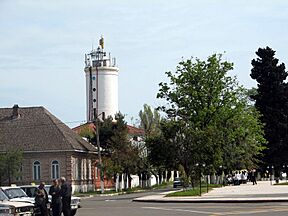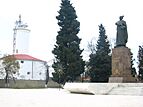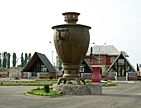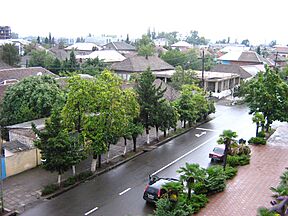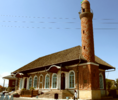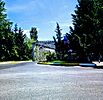Lankaran facts for kids
Quick facts for kids
Lankaran
Lənkəran
Lankon |
||
|---|---|---|
|
City
|
||
|
Lankaran Lighthouse
Lankaran Springs & Wellness Resort
Lankaran International Airport
Palace of Talysh Khans
Zindan Fortress
Boyuk Bazar Mosque
Kichik Bazar Mosque
Statue of Hazi Aslanov
Statue of Samovar
A street in Lankaran
|
||
|
||
 |
||
| Country | ||
| Region | Lankaran-Astara | |
| Area | ||
| • Total | 70 km2 (30 sq mi) | |
| Population
(2021)
|
||
| • Total | 89,300 | |
| Time zone | UTC+4 (AZT) | |
| Area code(s) | +994 025 25 | |
Lankaran (Azerbaijani: Lənkəran, , Talysh: Lankon) is a city in Azerbaijan, on the coast of the Caspian Sea, near the southern border with Iran. As of 2021, the city had a population of 89,300. It is next to, but independent of, Lankaran District. The city forms a distinct first-order division of Azerbaijan.
The city is mostly populated by the Talysh people, and serves as the main urban centre of this people and its ethnic homeland, Talish (Talyshstan). Historically, the city was the capital of the Iranian province of Talish, of Talysh Khanate, of Russian Lenkoran uezd, of Provisional Military Dictatorship of Mughan, of Mughan Soviet Republic and of Talysh-Mughan Autonomous Republic.
Contents
Etymology
The origin of the name "Lankaran" is uncertain. One theory consider it to derive from one of the Persian words, Langarkunān ("the place for dropping the anchor(s)") or Langarkanān ("the place for weighing anchor(s)"). Both meanings simply translate as "sea port." The pronunciation shifted through the years, and Langarkunān became Lankarān or, in the even more simple Talysh pronunciation, Lankon. The other theory links it to the Talysh word lankran ("cane house").
History
It is unknown when the town of Lankaran was actually established. The French archaeologist Jacques de Morgan (died 1924) discovered extremely ancient remains in Lankaran, such as dolmens and graves.
With the death of Nader Shah (r. 1736–1747), the Talysh Khanate was founded by Seyyed Abbas, whose ancestors were members of the Iranian Safavid dynasty, and had moved into the Talish region in the 1720s during a turbulent period in Iranian history. From the founding of the khanate until 1828, it was under the suzerainty of the Iranian Zand and Qajar dynasties. In the first half of the 18th century, the Russians gained control over it for a few years during the Russo-Persian War of 1722–1723; in 1732 it was ceded back to Iran by the Treaty of Resht. During the Russo-Persian War of 1804–1813, General Kotlyarevsky, heading the southernmost Russian contingent during the war, stormed and captured Lankaran's fortress. Following the Treaty of Gulistan of 1813, it was ceded to Russia. Qajar Iran would later retake the city during the Russo-Persian War of 1826–1828, but was forced to return it following the Treaty of Turkmenchay (1828), which saw the definite end of Persian influence in the South Caucasus.
Under Russian rule, Lankaran, known as Lenkoran (Ленкорань) in Russian, was the center of the Lenkoran Uyezd of the Baku Governorate. Following the collapse of the Russian Empire, it was a part of the short-lived Azerbaijan Democratic Republic (1918–1920), then became a part of the Azerbaijan Soviet Socialist Republic following the sovietization of Azerbaijan. In 1991, following the dissolution of the Soviet Union, it became a part of independent Azerbaijan.
Geography
There are sandy beaches near Lankaran. Thermal sulphide, chloride, sodium-calcium waters of Andjin (Upper and Lower) mineral springs are situated 12 km west of the town. Also to the west are the ruins of Ballabur castle, near the village with the same name.
Vast area of this region is covered by national parks, where a variety of fauna and flora are preserved. Gizil-Agach State Reserve hosts over 250 kinds of plants, 30 species of fish and more than 220 kinds of birds. Lankaran is also known for Parrotia, or ironwood. It is naturally grown in the region and could be seen in Hirkan National Park. Local myth has it that it is the only wood that sinks in water, hence the name (ironwood). Historically it has been used for heating since it burns for a long time and is not easily extinguished. The Persian leopard (Panthera pardus saxicolous) subspecies of the leopard, lives in the national park as well. In 1937, members of the Opilio lepidus species of harvestman were sighted in the area.
Climate
Lankaran has a hot-summer Mediterranean climate (Köppen climate classification: Csa), with cool, wet winters and very warm, highly humid summers, albeit with infrequent rain.
| Climate data for Lenkaran | |||||||||||||
|---|---|---|---|---|---|---|---|---|---|---|---|---|---|
| Month | Jan | Feb | Mar | Apr | May | Jun | Jul | Aug | Sep | Oct | Nov | Dec | Year |
| Mean daily maximum °C (°F) | 7.2 (45.0) |
7.2 (45.0) |
11.0 (51.8) |
17.5 (63.5) |
22.5 (72.5) |
27.2 (81.0) |
30.4 (86.7) |
29.5 (85.1) |
25.9 (78.6) |
19.9 (67.8) |
14.1 (57.4) |
10.1 (50.2) |
18.5 (65.4) |
| Daily mean °C (°F) | 3.6 (38.5) |
4.1 (39.4) |
7.5 (45.5) |
13.1 (55.6) |
17.8 (64.0) |
22.4 (72.3) |
25.3 (77.5) |
24.6 (76.3) |
21.4 (70.5) |
15.9 (60.6) |
10.4 (50.7) |
6.3 (43.3) |
14.4 (57.9) |
| Mean daily minimum °C (°F) | 0.0 (32.0) |
1.0 (33.8) |
3.9 (39.0) |
8.6 (47.5) |
13.1 (55.6) |
17.5 (63.5) |
20.1 (68.2) |
19.7 (67.5) |
16.9 (62.4) |
11.8 (53.2) |
6.7 (44.1) |
2.5 (36.5) |
10.2 (50.3) |
| Average precipitation mm (inches) | 91 (3.6) |
114 (4.5) |
90 (3.5) |
50 (2.0) |
54 (2.1) |
22 (0.9) |
17 (0.7) |
50 (2.0) |
143 (5.6) |
259 (10.2) |
168 (6.6) |
88 (3.5) |
1,146 (45.2) |
| Average precipitation days (≥ 1.0 mm) | 9.7 | 8.8 | 10.4 | 7.8 | 6.9 | 3.5 | 1.8 | 3.6 | 7.9 | 12.7 | 10.1 | 8.2 | 91.4 |
| Average rainy days | 10 | 10 | 11 | 8 | 8 | 3 | 2 | 4 | 7 | 13 | 12 | 9 | 97 |
| Mean monthly sunshine hours | 105.4 | 98.9 | 124.0 | 171.0 | 226.3 | 282.0 | 306.9 | 254.2 | 189.0 | 127.1 | 99.0 | 108.5 | 2,092.3 |
| Source 1: World Meteorological Organization (UN) NOAA(Precipitation and rain days) | |||||||||||||
| Source 2: Hong Kong Observatory (sun only) | |||||||||||||
Economy
Dominating spheres in the economy of Lankaran are vegetable-growing, tea-growing, paddy cultivating, cattle-breeding, citrus plants, beekeeping, fishing, and grain farming. Favourable humid subtropical climate, availability of good arable land, water and sufficient labour resources of the city provides a good basis for agricultural activities as well as the development of agro-processing enterprises. The city is also home to Azerbaijan's first tea plant, built in 1937.
Demographics
Lankaran is the capital of the Talysh region (Talyshistan), the ethnic homeland of the Talysh people, and the main urban and cultural center of this people.
The vast majority of the population of Lankaran is Talysh, and the rest are Azerbaijanis and other nationalities.
Religion
The religion with the largest community of followers is Islam. The majority of the Muslims are Shia Muslims, and the Republic of Azerbaijan has the second-highest Shia population percentage in the world after Iran. The city's notable mosques include Kichik Bazar Mosque and Boyuk Bazar Mosque.
Culture
As of 2012, the city along with Baku and Ganja participated in Earth Hour movement.
Cuisine
Lankaran's cuisine has largely been affected by its multicultural history, hence the large variety of food originating during Talysh Khanate. Lankaran's signature cuisine includes lavangi, Lankaran kulcha, marji plov, white plov, pumpkin plov and turshu kebab.
Music and media
Lankaran is home to several national folk performers, including the Bacılar (The Sisters) national Talysh folk and dance collective.
The regional channel Janub TV and newspaper Lankaran are headquartered in the city.
Sports
The city used to have a professional football team competing in the top-flight of Azerbaijani football - Khazar Lankaran, which played in the Azerbaijan Premier League. Sporting venues in the city include the Lankaran City Stadium and Lankaran Olympic Sports Complex. The stadium was one of the venues for the group stages of the 2012 FIFA U-17 Women's World Cup.
In 2012, the city won to host European Masters Weightlifting Championship.
Transport
Air
The Lankaran International Airport's international terminal was opened in September 2008.
Railway
The city has rail service from historic terminals in downtown to Baku in the east and Astara in the south.
Education
Lankaran State University is located in the city. It was founded in 1991 and it was Lankaran's first university to start courses.
Twin towns
Lankaran is twinned with:
Gallery
See also
 In Spanish: Lankaran (ciudad) para niños
In Spanish: Lankaran (ciudad) para niños


